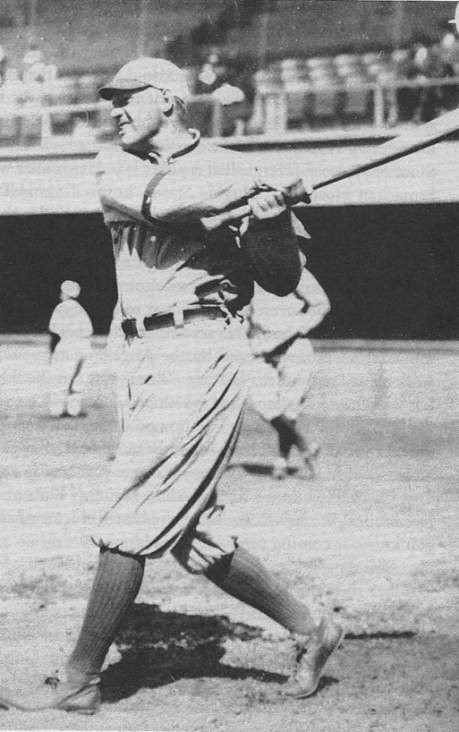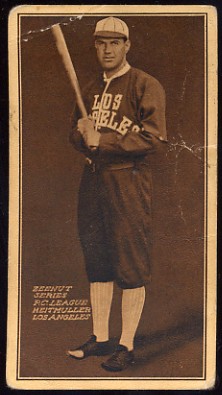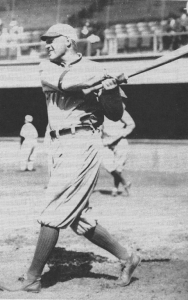Historical Hitter November 1st: William Fredrick “Heinie” Heitmuller

 For years the Pacific Coast League played the longest schedule in baseball, running from early April to the last week of October, with some years ending November 1st.
For years the Pacific Coast League played the longest schedule in baseball, running from early April to the last week of October, with some years ending November 1st.
In 1912 the season ended on the 28th with the Oakland Oaks winning the six team league title by 5 full games, 112 -79 .539 with Vernon Tigers coming in second at 106-79 .574.
The team of interest was the old Los Angeles Angels who finished third with a record of 104-82 .559, that year the San Francisco Seals were not especially good and finished fifth place at 82-107 .434 winning percentage.
Yet the year belongs to a former Philadelphia Athletic outfielder, Heinie Heitmuller who batting a robust .335 with a .471 slugging percentage. He played in 151 games had 556 at bats, knocked out 186 hits 29 doubles,1 triple, 15 home runs and had 262 total bases.
He was 6-2 and 215 pounds of muscle and talent and was also an excellent football player at University of California. On the gridiron, he was noted for the scoring the winning touchdown for Cal in the Big Game and playing alongside Cubs pitcher Orval Overall.
Connie Mack signed Heitmuller, and had great expectations for Heitmuller becoming a power hitting outfielder for the Athletics. F.C. Richter wrote the following report on Heitmuller that was published in the Philadelphia based Sporting Life in 1908:
“If Heitmuller hits for the Athletics like he did for Oakland last year his job will be secure. There will be nothing to it. San Francisco cranks have had scant idea of Heitmuller’s ability as a fielder. The Recreation Park right field is too small to give a player an opportunity to display his skill, but Heitmuller has a strong arm and gets over a lot of ground in quick time. The Dutchman was delighted when he heard that Mack drafted him, for he has been anxious to try his hand in faster company for a year or more. When he was at Honolulu last winter report reached there that he had been disposed of by Oakland to Philadelphia, and the smile wouldn’t come off his face for days afterward.”
In the in the dead ball era of 1908 in Oakland he lead the league in hitting and home runs which lead to his signing by the A’s. The Sporting Life reported on December 12, 1908 as part of its hot stove reporting that,
Outfielder Henry Heitmuller, drafted by the Athletics from Oakland, has a great record according to the Pacific Coast League averages. He played in 205 games, made 104 runs. 225 base hits (Including 39 doubles, 1 triple and 12 home runs), stole 39 bases and made 31 sacrifice hits. His batting average was .284.
 On New Year’s Day 1909 in Manila he put on a one man home run hitting derby, and hit balls further than anyone had ever seen in Manila. H.G Baggerley, the syndicated reporter, who followed the team 1908 Reach All Americans on their journey, described the home runs hit by Heitmuller as,
On New Year’s Day 1909 in Manila he put on a one man home run hitting derby, and hit balls further than anyone had ever seen in Manila. H.G Baggerley, the syndicated reporter, who followed the team 1908 Reach All Americans on their journey, described the home runs hit by Heitmuller as,
…an exhibition of hitting before leaving Manila which startled the natives. Twice he pelted the ball over centerfield enclosure and it was the first time that a home run had ever been made by this route. Centerfield fence stands a long distance back. …yet both times Heine batted the ball so it dropped full ten feet clear of the boards.
(This was the old wooden stadium that was demolished and replaced by the Manila Carnival Grounds for the 1913-1914 World Tour and 1913 Inaugural Far Eastern Games, it was estimated that centerfield was well over 400 feet.)
Baggerley was just as optimistic that Heitmuller would be a success in the American League with the A’s especially with the short right field wall at the Shibe Park, he reported with great expectations declaring that Heitmuller,
Should he hit the ball halt as hard for Philadelphia this summer he will be quite the biggest thing in baseball. And there is no reason why Heine shouldn’t swat the ball.
When Heitmuller made it to the A’s Spring Training site in 1909 he was in competition for the fourth outfield spot with a young outfielder from Greenville South Carolina, one Shoeless Joe Jackson. After Heitmullers’ spring, Connie Mack selected Heitmuller as his outfielder and sent the shoeless Joe back to the minors for further development.
Sometimes even the best baseball minds get it wrong, and with Heitmuller and Jackson, Mack did not get it right.
Heitmuller, while a baseball hero in Oakland, never caught on with the A’s. He played 95 games in one and a half seasons under Mack’s careful eye, while managing a respectable .271 average, however, hitting zero home runs. More importantly, he failed to come through in the clutch at the plate and was a liability in the field. On the hitting issue, the July 30 Edition of Sporting Life noted,
…while in the second game Heitmuller failed repeatedly to hit the ball out of the diamond when even a sacrifice fly would have yielded the winning run. This spurred Manager Mack to action,..
By August 6th, it was announced that Heitmuller was transferred to the Old Baltimore Orioles of the International League as a player to be named later. As a act of decency and a sign that we was well liked by his mates, Heitmuller was given a $500 World Series bonus check when the A’s won the 1910 World Series.
After a mediocre half season in Baltimore, perhaps home sick, Heitmuller returned to more familiar grounds of the Pacific Coast and signed on with the Los Angeles Angles for the final half season in 1911.
Back in California Heitmuller excelled, he hit .343 in that half season – some 300 PCL at bats. He used a hefty 42-oz thin handled Frank Schulte model bat made by AG Spalding & Bros. (Yet the Spalding’s Guide notes that the Frank Schulte Autograph bat was 36 to 41 oz.).
On August 24, 1912 in Oakland, Heitmuller thundered a game winning home run that cleared the fence and rattled the shingles of a house across the street from the park. Soon after he went into a deep slump and complained about having some flu-like symptoms. His health and batting slump showed signs of improvement a month later on September 27 with a six-for-six game that featured two doubles. Yet, two days later on the 29th he was out of the lineup. The team trainer looked him over and almost immediately noticed that he was suffering from symptoms similar to those of typhoid fever. Heitmuller was hospitalized. A week later, on October 8, 1912 he died.
It was devastating.
Black crepe covered the entrance to the Angles front office, and the flag was flown at half-mast. His teammates were stunned as was the entire Pacific Coast League. As the Angeles took the train for a road trip north, the mood was stunned silence and heavy. Since Heitmuller was from the Bay Area, his coffin and brother accompanied the team train as they headed to San Francisco.
“But it was not the ‘Heine’ at whose shrine the fans from Los Angeles to Portland had worshipped for two seasons. It was merely the husk of a home run king. The powerful muscles were no longer pliant; the keen eye was unseeing, and the ears which had heard the cheers of applauding thousands were deaf to the farewells of his baseball mates; who were gathered in a mournful group.”
As with all professional sports, the games must be played and the season continued. When their game was played in Oakland, the Angels at the exact time of their fallen hero’s funeral in San Francisco vacated the field, the crowd fell silent, and the entire stadium held a 10-minute long moment of silence.
The Angeles could not overcome their grief and fell to third place in the PCL. With over 580 at bats, Heitmuller’ s .335 Batting average, which was second in the PCL, held.
When the season ended, Heitmuller’s 15 home runs were good enough for second; almost miraculously, his .335 average was the League’s Best.
Thus on All-Saints Day the Historical Batter of the Day is an Angel from Los Angeles, who was the only dead man to win a batting title, Heinie Heitmuller.
[divider]
Old Baseball Cards: http://www.starsofthediamond.com/zeenuts.html
Baseball-reference.com
Snelling, Dennis, The Greatest Minor League: A History of the Pacific Coast League, 1903-1957. Jefferson, North Carolina: McFarland & Co. 2012.
